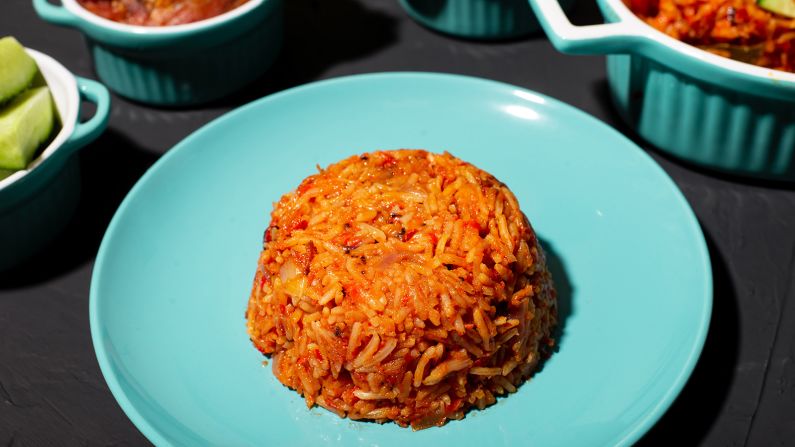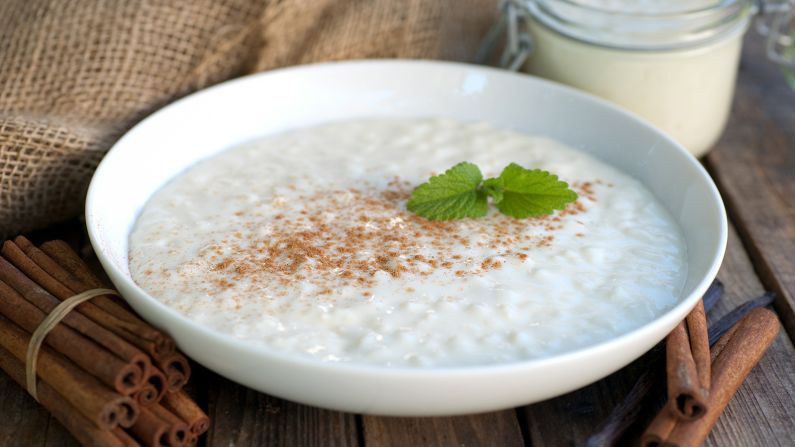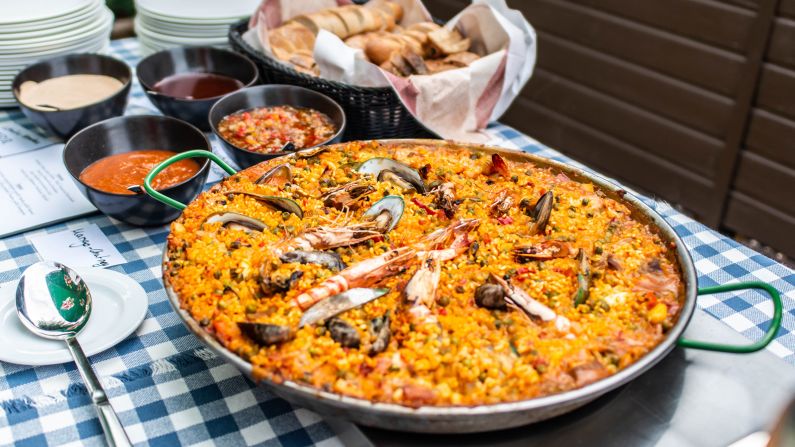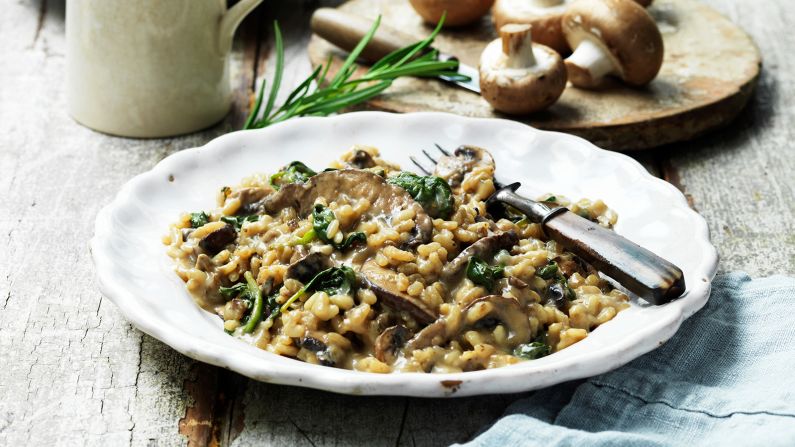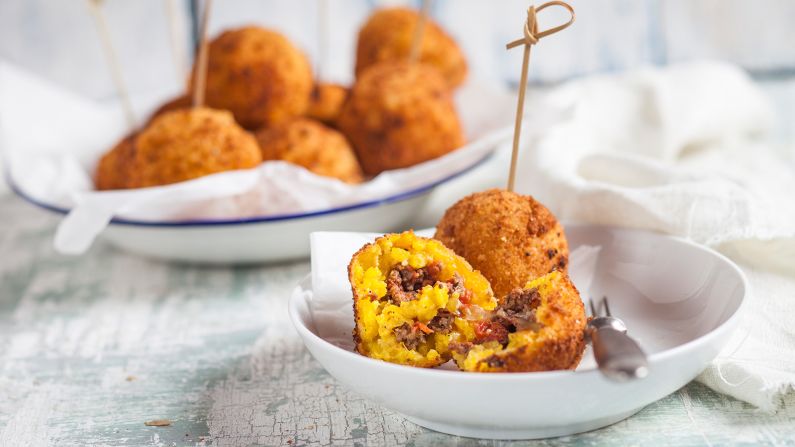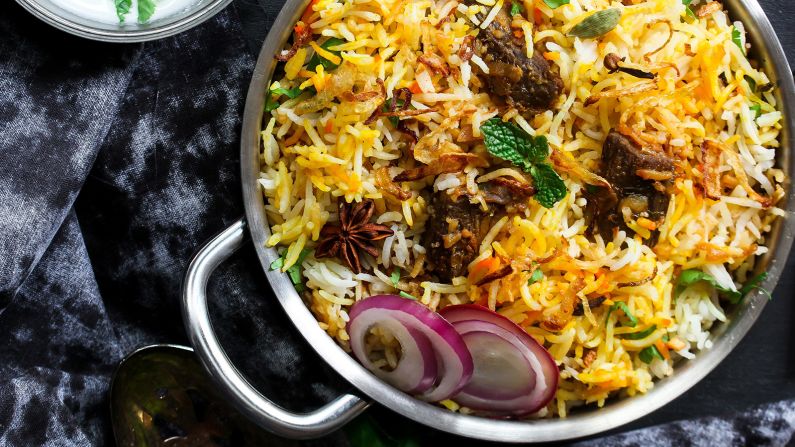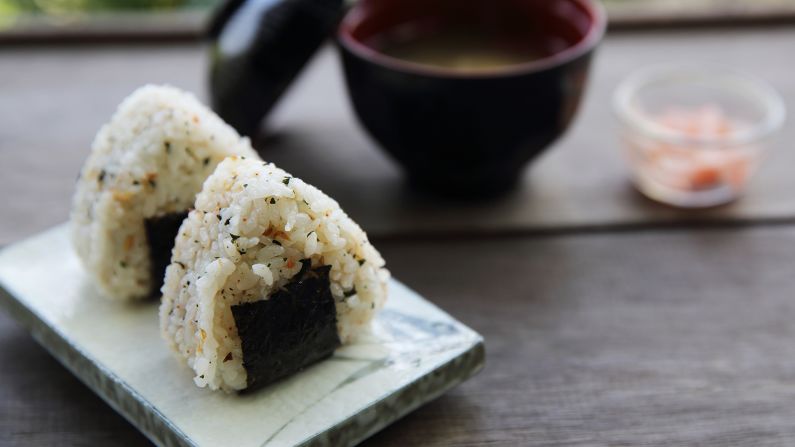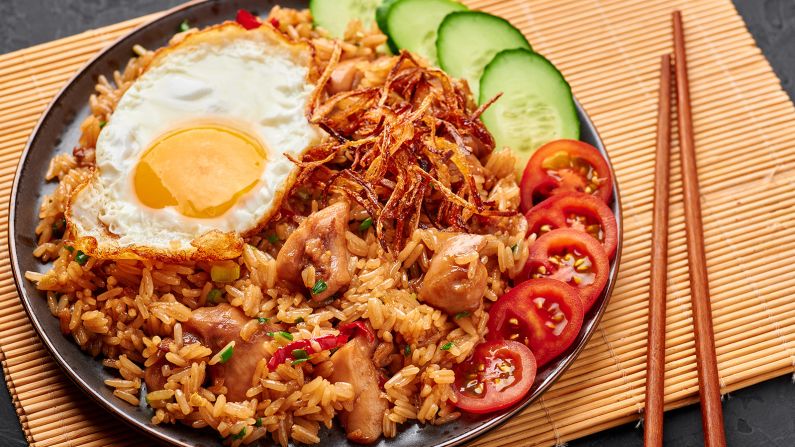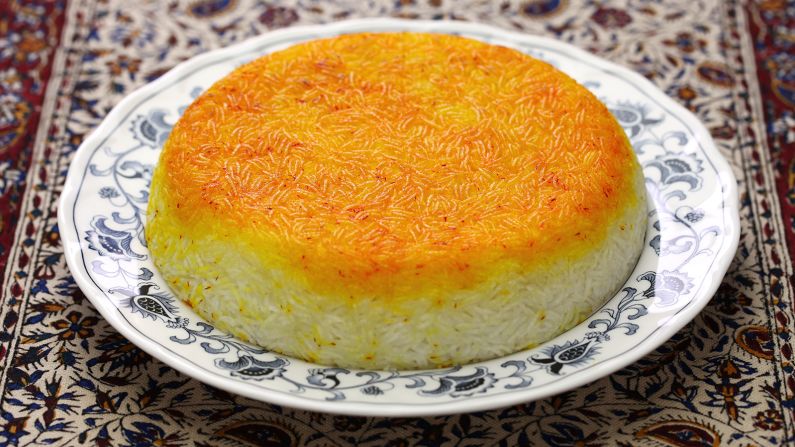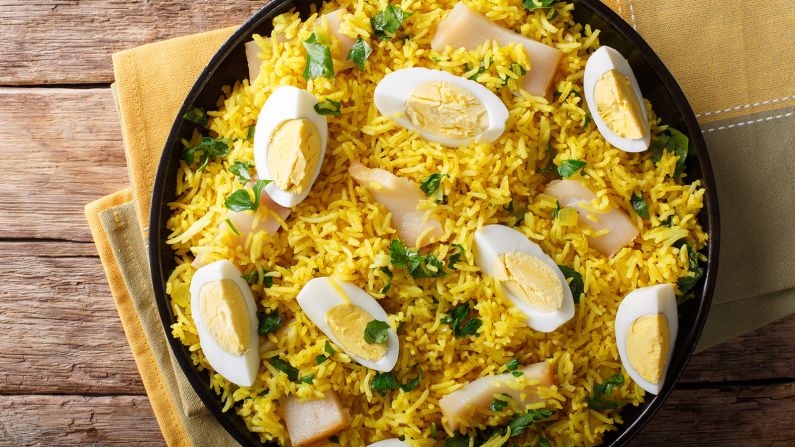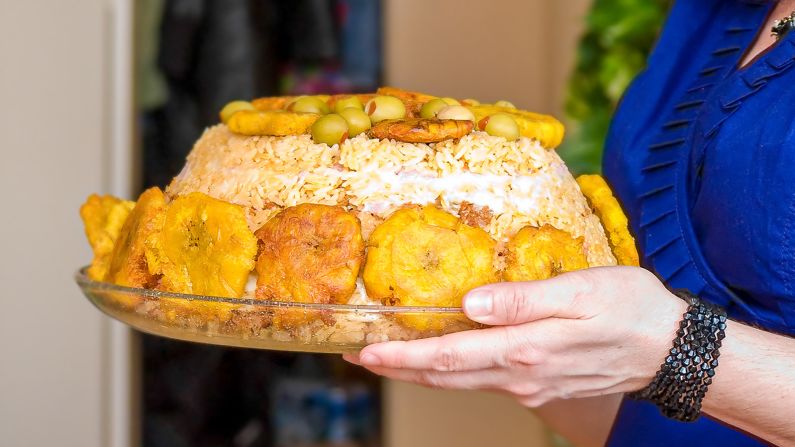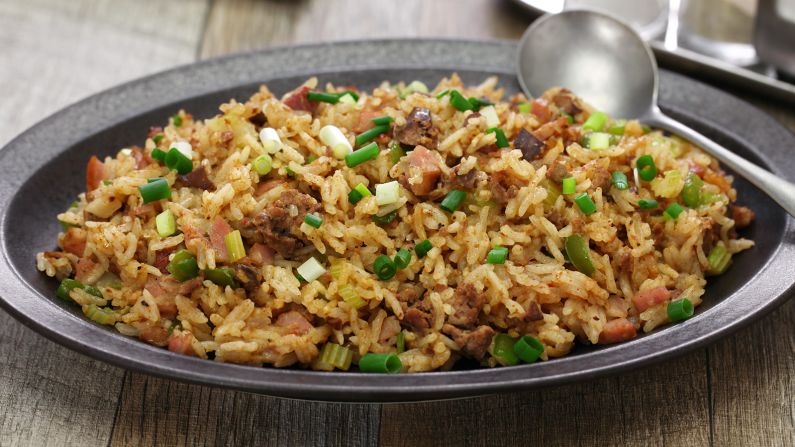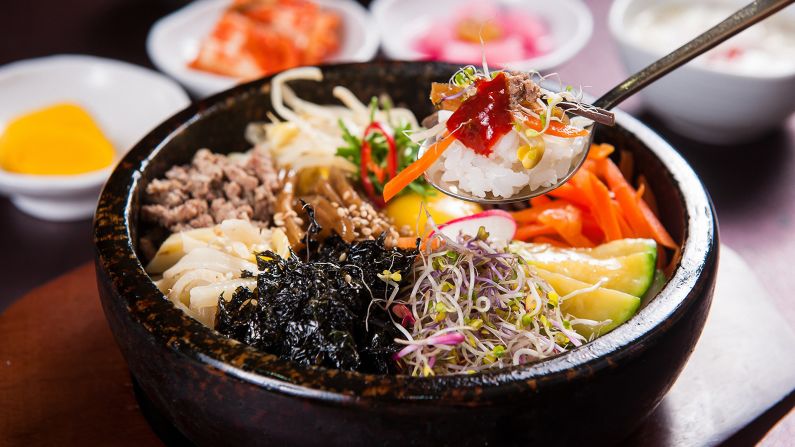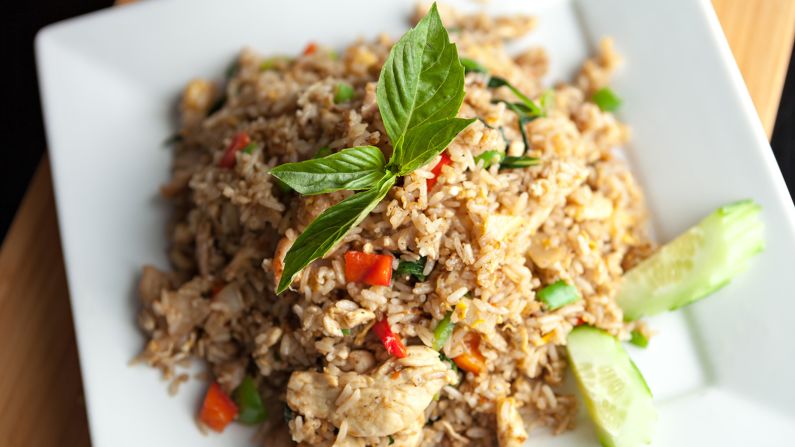With thousands of varieties of rice in the world – jasmine, basmati, arborio and Carolina Gold, to name just a few – is it any surprise the grain defines iconic meals everywhere from Singapore to South Carolina?
Plus, half the world’s population relies on rice as a staple, so there have been plenty of culinary innovators over its long history.
And while famous rice dishes such as sushi, fried rice and paella are among the most prominent in the global spotlight, there are so many more rice recipes out there to put on your radar – and seek out on your travels.
Here are 20 dishes from international crowd-pleasers to some that you may not have tasted – yet:
Jollof, West Africa
Widely enjoyed in West African countries for special occasions such as weddings, birthdays and funerals, jollof is a one-pot rice dish made by cooking rice, onions, tomatoes, meat and spices in a single vessel.
“Sierra Leone, Ghana and Nigeria argue over who makes the best jollof, but it really comes down to who’s cooking it,” says Sierra Leonean fashion designer Mary Ann Kai Kai of Madam wokie.
Typical Ghanaian jollof incorporates more spices than Nigerian jollof and also usually uses an aromatic rice, such as basmati, instead of the long grain rice more typical in Nigerian jollof. But jollof recipes can vary within the same country, too.
The dish is said to have originated in Senegal, but the debate over who makes the best jollof on the continent and across the diaspora will never end.
Zongzi, China
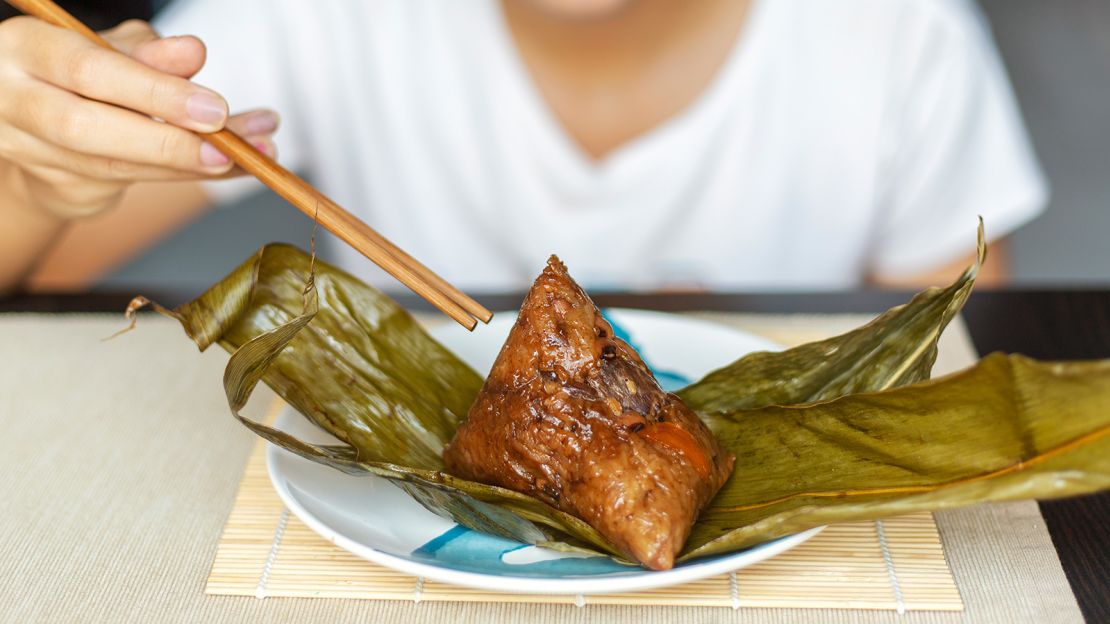
Found in various iterations all over China, zongzi refers to sticky, glutinous rice dumplings wrapped in bamboo leaves before boiling that can be stuffed with savory or sweet fillings.
And while anything that is wrapped with a skin and has a stuffing is considered a dumpling, says Nadia Liu Spellman, author of “Dumpling Daughter: Heirloom Recipes from our Restaurants and Home Kitchens,” the Chinese put zongzi is a category of its own.
Typical zongzi fillings in southern China include salted duck egg and pork belly while sweeter fillings such as red bean paste and tapioca are more common in the north of the country.
“Every family recipe has their own secrets that they believe make their zongzi superior,” Spellman says.
Milchreis, Germany
A stovetop staple at many a German oma’s house, milchreis (translation: milk rice), is a creamy rice pudding made from arborio, medium or long grain white rice that’s sweetened with cinnamon and sugar and splashed with vanilla extract.
It can be enjoyed warm, straight from the stovetop, or chilled. It’s a nostalgic childhood snack that’s often enjoyed by adults across Germany, too. You can even buy pre-made containers of milchreis in the refrigerated sections of German grocery stores.
Far from the only country to concoct a sweet treat featuring rice and milk, German milchreis is joined by Lebanese meghli, Indian kheer, Portuguese arroz doce, Latin American arroz con leche and many, many more in the rice pudding family.
Paella, Spain
A gift to global gastronomy, Spain’s main rice player is paella, the famous dish from Valencia that originated as a peasant food and is typically made using bomba rice, which maintains its firmness while absorbing the broth while cooking.
The dish was originally invented in rural areas and made use of whatever ingredients were available, including rice, chicken, rabbit and snails mixed with saffron, olive oil and the vegetables of the season, says Patricia Palacios of Spain travel website, España Guide.
“Today, there are many different paella recipes,” she told CNN Travel. “Along the coast, fish and seafood paellas are very popular. Vegetarian paellas are also common. But most Spaniards would agree that a big no-no with paellas is mixing meat and fish/seafood.”
Risotto, Italy

Making Italy’s most famous rice dish is an art form that requires near constant stirring on the part of the cook. And any Italian will tell you risotto must be “all’onda” (translation: on the wave) – with a texture that undulates enough to fall off the spoon without ever taking on the dreaded globby consistency.
With its high starch content, arborio rice is most commonly used in making the dish, typically served as a first course in Italy.
“Risotto is comfort food,” says Calabria-born cookbook author Francesca Montillo, who leads culinary tours in Italy. “It’s not necessarily an easy dish to prepare, so it also speaks to the skills of the chef or home cook preparing it.”
The traditional preparation, Montillo says, involves first toasting the rice then adding wine as it cooks in the broth, with butter and grated cheese added later. Variations include adding peas, mushrooms, asparagus and ham, among other ingredients.
Arancini, Italy
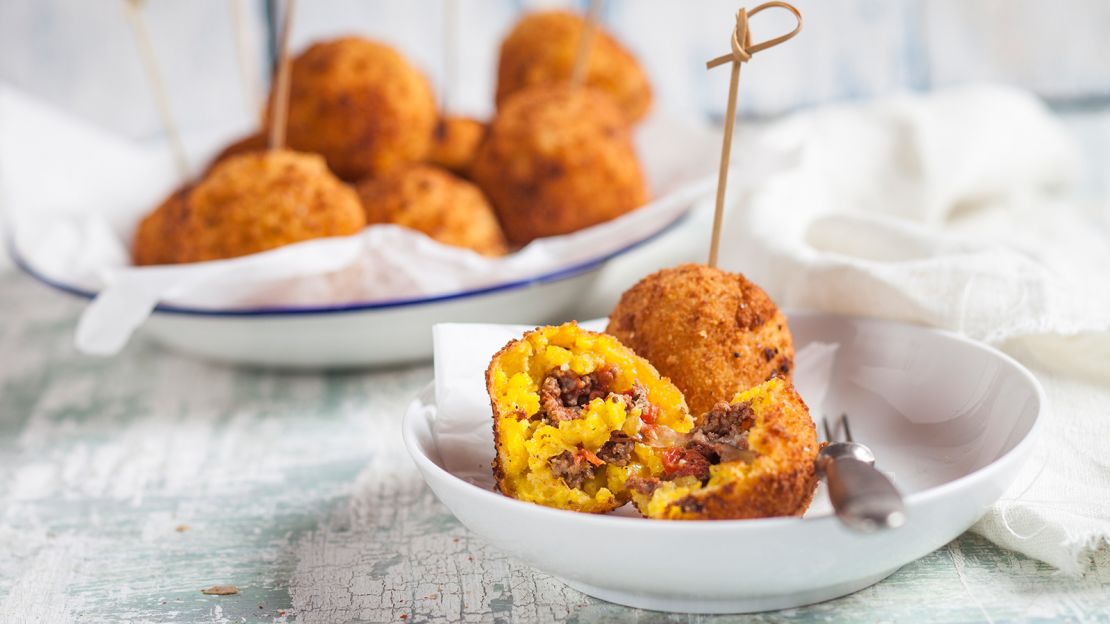
Sicily’s most famous street food is the rice ball whose name comes from the orange citrus fruit it resembles in shape and color. Arancini is essentially stuffed rice balls that are breaded and fried, says Montillo. And Sicilians debate the dish’s name.
“In Palermo, it’s typically round and the name is arancina,” she says. “In Catania, it’s cone-shaped, some say to resemble the local Etna volcano, and it’s called arancino.”
You can find the dish all over Sicily as well as on mainland Italy, but arancini are particularly linked to Siracusa’s Festa di Santa Lucia (Feast Day of St. Lucia), celebrated every year on December 13. The balls are usually stuffed with meat sauce, says Montillo, and other fillings might include peas, mozzarella, prosciutto, spinach and eggplant in tomato sauce (“alla Norma”).
Biryani, India
Beloved across the Indian subcontinent and said to have originated in Iran (birinj biriyan means “fried rice” in Persian), biryani is almost always on the menu for special occasions in India, says cookbook author Vasanti Bhadkamkar-Balan.
“It is a rich and elaborate preparation, made by layering partially cooked basmati rice with vegetables/lamb/chicken/fish in a sauce that is flavored with exotic spices and aromatics,” she said.
The pot is then covered and sealed with dough or a wet cloth that stops the steam from escaping while the biryani cooks over a low flame. Typical biryani spices include a wide aromatic mix, among them fennel seeds, mace, cardamom, bay leaves, coriander and garlic.
Kabuli pulao, Afghanistan
Afghanistan’s most famous rice dish, Kabuli pulao is a pilaf-style specialty. Served in many countries, rice pilaf is a loose-grain dish often cooked in stock with spices, onions and other ingredients.
Kabuli pulao is served piled high atop a platter and redolent with slow-cooked lamb and a blend of spices (cardamom pods, cloves, cinnamon and cumin among them), mixed with a long grain rice such as basmati.
The dish is usually topped with julienned carrots, raisins and toasted almonds. Kabuli pulao takes its name from the Afghani capital, Kabul, but is also enjoyed in neighboring Pakistan.
Onigiri, Japan
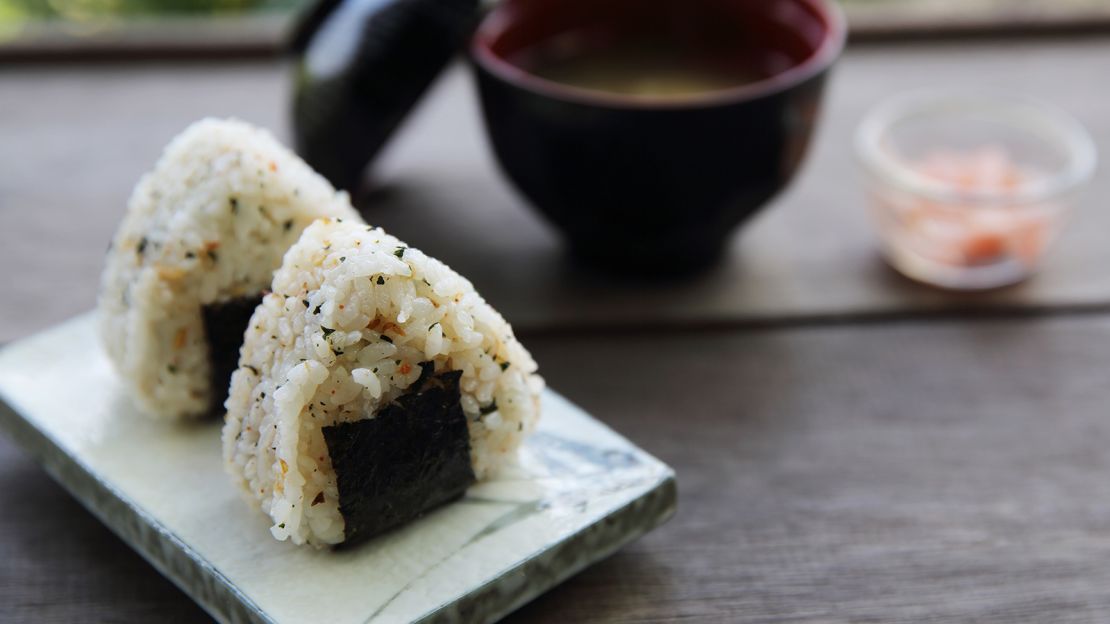
Sushi’s popularity precedes it. But just as dear to the Japanese is onigiri, a staple bento box snack made from steamed Japanese rice shaped into a triangular form and wrapped with the seaweed called nori.
“Despite its integral significance in Japanese culture, it is still an uncommon novelty in the United States, even in a metropolis such as New York,” says Ricky Dolinsky, co-owner and chef at New York City cocktail bar Paper Planes, which has styles of onigiri on its speakeasy menu.
Onigiri is special, he says, because of its convenience and affordability. “Onigiri reigns supreme in Japan,” says Dolinsky. “Whether it’s a quick grab-and-go on the way to work, or prepared at home for a lunch bento box.”
Nasi goreng, Indonesia
Nasi goreng translates to “fried rice” in the Indonesian and Malay languages and is an inexpensive and filling comfort staple served at street stalls and restaurants across the Indonesian archipelago, everywhere from Jakarta’s markets and Bali’s backpacker hangouts to the streets of Sumatra.
Mixing sweet and salty flavors, the dish is made from long grain rice flavored with a spice blend called bumbu (with shrimp paste, ginger, candlenut and other ingredients) and the sweet Indonesian soy sauce called kecap manis.
Variations of nasi goreng, which is considered a comfort food in Indonesia, incorporate eggs, shrimp and chicken. It’s often enjoyed with a side of spicy sambal sauce.
Tahdig, Iran

Fans of crispy rice will enjoy this Persian specialty typically made with basmati rice, yogurt, saffron and sometimes an egg yolk. Tahdig means “bottom of the pot,” referring to the dish’s crispy golden bottom of cooked rice that pairs perfectly with its fluffy interior.
Cooking fat on the bottom of the rice pan helps ensure the tahdig gets pan-fried below while cooking, while staying light and steamy up top. Saffron threads give it its golden glow.
Kedgeree, India/Britain
Said to have been a favorite of Queen Victoria, the Anglo-Indian dish called kedgeree traces its roots to the far more ancient spiced lentil Indian dish, khichiri, which dates to the 14th century.
A popular British comfort food today, kedgeree blends smoked haddock filet with basmati rice, hard boiled eggs and spices such as cumin, coriander and turmeric (the fish and eggs reflect the taste preferences of the British Raj, who appropriated khichiri to their palates).
Arroz imperial, Cuba
One of Cuba’s classic comfort rice dishes, arroz imperial is prepared for special occasions on the island and among the diaspora in Miami and elsewhere, too. It’s assembled in layers, much in the same way as lasagna.
Satisfying enough to be served as a main dish, it’s typically layered with yellow rice, shredded chicken, mayonnaise (to help bind it and for flavor) and cheese and is sometimes baked before serving for a melted effect. Olives, tomatoes and peppers are popular additions.
Pelau chicken and pigeon peas, Trinidad and Tobago
A one-pot comfort food ubiquitous in the dual-island Caribbean nation of Trinidad and Tobago, pelau is an everyday dish best shared with friends and family, says Jeanine Prime, the owner of Trinidadian restaurant Cane in Washington, DC.
To make it, she says, rice, peas and animal proteins (usually chicken) are caramelized and then cooked with stock, coconut milk and spices. The dish is often the centerpiece at social gatherings on the islands because it’s so filling.
“People eat it while hanging out at the beach, while taking in a cricket match, or even at dinner parties,” says Prime, who was born and raised in Trinidad. “It is to Trinidadians what jollof is to Ghanaians and Nigerians.”
Louisiana dirty rice, United States
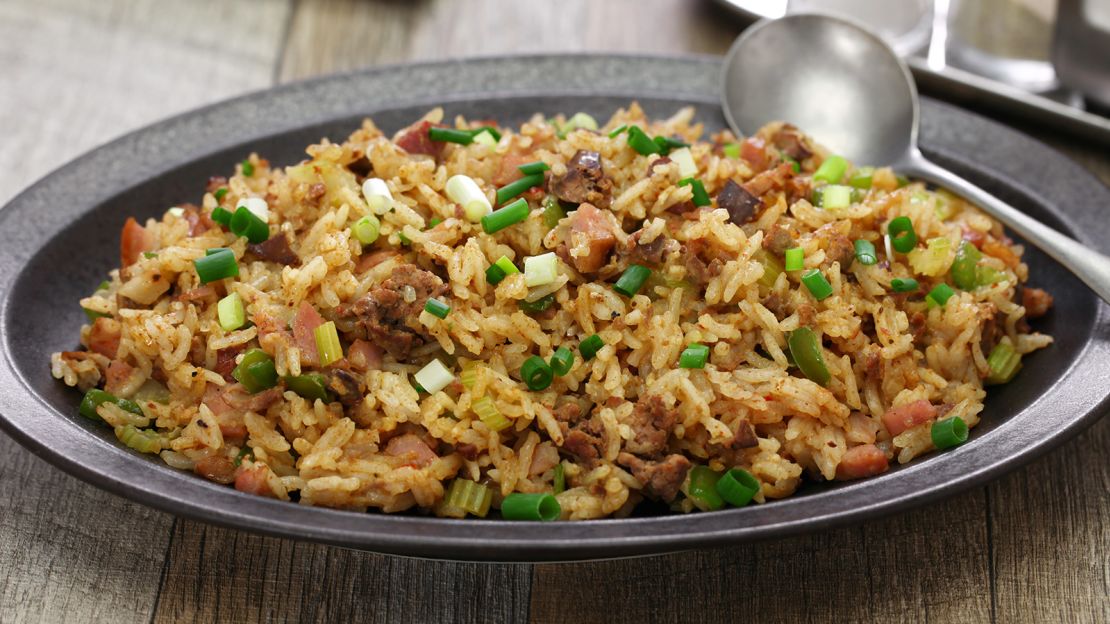
Also called Cajun dirty rice, this Louisiana classic preferably made from long grain rice from the marshes of southern Louisiana is enjoyed across the state – from the tables of home cooks in Lake Charles and Baton Rouge to cafeteria-style diners and upscale restaurants in New Orleans.
It’s as typical a side dish in these parts as mashed potatoes are elsewhere in the country. In traditional recipes, chopped chicken livers or gizzards give the white rice its “dirty” color.
Not to be mistaken for the popular Creole dish, jambalaya, dirty rice can also be made using ground beef and ground pork (if you don’t like innards) to give the rice its distinctive look.
Wali wa kukaanga, Kenya
Wali wa kukaanga is Kenya’s answer to fried rice, and translates to just that in Swahili.
Served alongside a meat dish or all on its own, it’s a straightforward meal that’s easy to prepare from common ingredients and consists of boiled rice fried together in oil with turmeric and a mix of chopped vegetables that might include onions, carrots, peas and corn.
Chicken Perloo, South Carolina, United States
Carolina Gold Rice is the preferred grain for preparing chicken perloo (also called perlo or purloo), a quintessential South Carolina Lowcountry dish that traces its roots to West Africa and the slave trade.
With similarities to paella and jollof, the dish consists of a protein simmered with rice, tomatoes, onion, garlic, celery, bell peppers and spices.
“Perloo’s importance – as with so much regional cuisine throughout the South – is that it reflects the blending of cultures from Africa and Europe that make this dish so unique to the South Carolina Lowcountry,” said Kiawah Island Golf Resort executive chef, John Ondo, in an email to CNN Travel.
The dish varies depending on where you are in the Lowcountry, he said, with less tomato used farther north.
“Gullah and Geechee cooks who make Perloo stick to tradition, passing these family recipes down from generation to generation,” he says. “The result is that there are as many subtle variations for Perloo recipes as there are cooks and ways to spell it.”
Alaisa fa’apopo, Samoa
Coconut figures big in the cuisine of tropical Samoa, from coconut rolls and bread to coconut cookies and meat and vegetable dishes that incorporate the milk.
So it’s no surprise that the Polynesian island country’s most popular rice dish, alaisa fa’apopo, has ties to the coconut, too. A popular savory snack, it’s made from coconut cream mixed with steamy salted rice and is often served with coffee or a cup of koko Samoa (Samoan hot chocolate).
Bibimbap, South Korea
This wildly popular Korean dish whose name translates to “mixed rice” has gained fame around the globe and consists of rice served in a bowl and topped with a colorful array of individually prepared meats and artfully sliced vegetables.
The city of Jeonju in western South Korea, where the rice is cooked in a broth made from beef brisket, is the most famous place to try it. The dish is often served with the Korean hot chili condiment called Yak-gochujang.
Thai fried rice (Khao Pad), Thailand
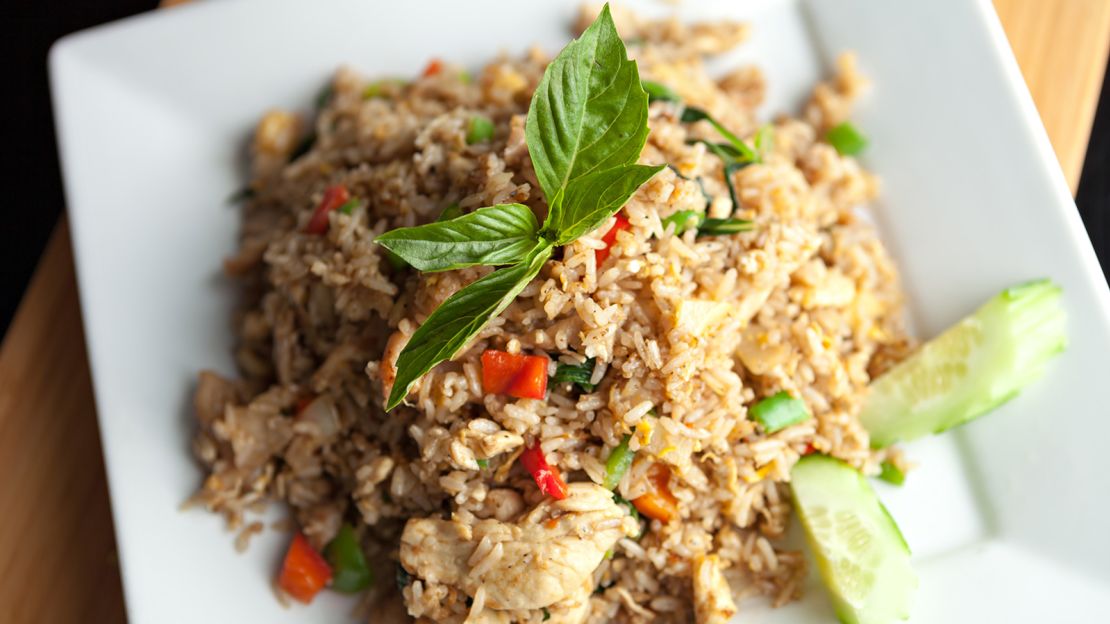
When it comes to fried rice, the Chinese version tends to steal the spotlight. But Thai fried rice, called khao pad, is just as worthy of acclaim and a similar staple at home tables (not to mention from street food vendors) in the southeast Asian country.
Hom mali –Thai jasmine rice that’s considered the “Champagne of rice” – serves as the base for the dish, says Thailand-born chef Vanda Asapahu of Los Angeles restaurant Ayara Thai.
“Layering of flavors is important in Thai food and extends to its fried rice,” she says, noting the importance of balancing salty and sweet. “You also need a hot wok and good eggs, and for sure white pepper and scallions to finish off the dish, all of which are basic essentials in a Thai kitchen.”
